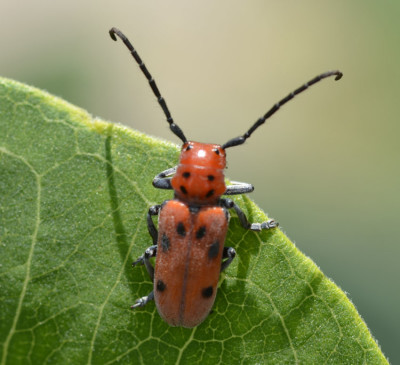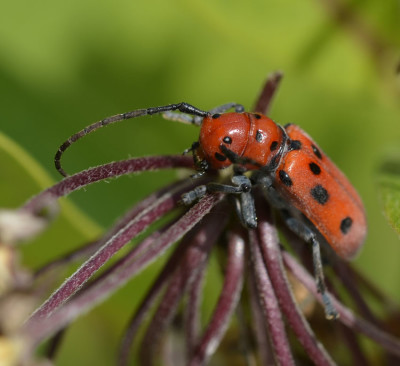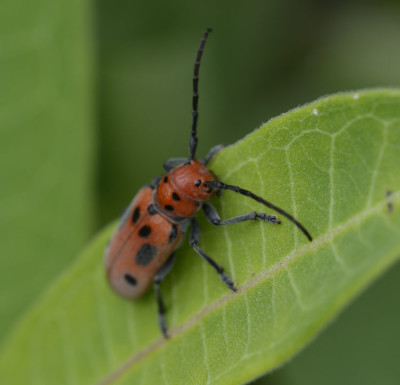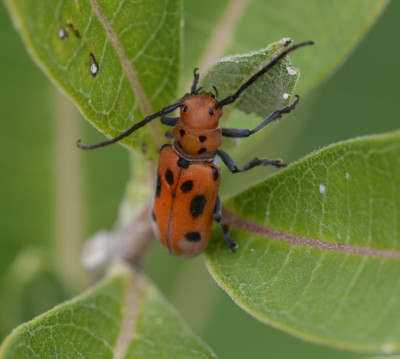While keeping an eye out for Monarch butterfly caterpillars, I keep seeing the other types of insects that feed on Common Milkweed. I wrote an article recently introducing the Milkweed Tussock Moth caterpillar. This time, I’m talking about a type of beetle that is very common on Milkweed in southern Ontario, far more commonly seen that any of the caterpillars.
(There are actually several different red and black insects that feed on Milkweed plants in southern Ontario. One set are beetles and the other set are bugs. I’ll have to write a post on the bugs next.)
Milkweed Beetles Have Black Spots, Long Black Antenna, and Red Shells
Aside from the vivid black and red colouring, Red Milkweed Beetles are particularly noticeable because they have long black antenna. According to a University of Wisconsin website, they are a member of the long-horn beetle family, just like the Asian Long-horned Beetle that sometimes gets in the news when areas in North America are quarantined to eradicate it. These Red Milkweed Beetles, however, offer no threat to our forests and are native to North America.
Do Red Milkweed Beetles Eat the Leaves of Common Milkweed?
Yes, adult beetles do eat the leaves. The young, however, eat the roots of the milkweed plants and live underground. This is quite different from Milkweed Bugs which are an unrelated insect.
According to BugGuide.net, they have been reported on other types of Milkweed but appear to prefer Common Milkweed.
Does Eating Milkweed Make These Beetles Toxic to Predators?
When insects eat the sap in milkweed plants, they take in some chemicals called cardenolides (cardiac glycosides) that are poisonous to many mammals, birds and other animals. That does not mean that a Blue Jay who eats a single Monarch caterpillar will die: the jay will feel poorly though. Many insects that eat milkweed have bright colours, like these Red Milkweed Beetles, that may help cause birds and animals to avoid eating them again to avoid a second bout of illness.
The toxicity of Milkweeds, including Common Milkweed, is one of the reasons that these plants used to be classified as a danger to livestock by many jurisdictions. It was often mandatory to spray and remove Milkweed because it can poison poultry, sheep, cattle and other grazers. Now due to extensive lobbying from Monarch-lovers many places have repealed these laws so that Common Milkweed can be allowed to grow along roadsides and in private gardens.
Do I Need to Kill Red Milkweed Beetles If I Want to Help Monarch Butterflies?
No. Monarchs and Milkweed Beetles have co-existed for hundreds of years. There’s no need to destroy a normal healthy part of the food web just to help Monarchs.
Why I Look Forward to my Next Encounter with a Red Milkweed Beetle
According to one article I was reading, these beetles actually make sounds including a purr and a whine. I’ll have to try to tune in the next time I encounter some!
Related Reading
- Not Every Long-horned Beetle Is Endangering Our Forests
- Milkweed Predators: Milkweed Tussock Moth Caterpillars
- Milkweed Predators: Monarch Butterfly Caterpillars
- Milkweed Predators: Large and Small Milkweed Bugs
- Black and Red Box Elder Bugs Buzzing Up a Storm at Riverwood
- Further info on sounds made by Red Milkweed Beetles
Join In
Have you seen some of these long-horned beetles on your local patch of Milkweed? Did you hear any of them purr? Please share your sighting with a comment.






